This is blog/report 1 of my October ‘person-centred’ US study tour. These blogs will be long as I condense many visits from each US state into weekly posts. See my facebook and twitter posts for regular commentary and onsite photos.
I am fortunate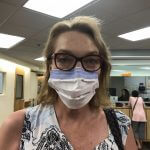 to have family living in the US who (although they think I am weird) have kindly allowed me to accompany them on their medical appointments and experience care from a patient perspective. I am also travelling with a clinician so will report from their clinical perspective as well as my usual Practice Management and Health IT perspectives.
to have family living in the US who (although they think I am weird) have kindly allowed me to accompany them on their medical appointments and experience care from a patient perspective. I am also travelling with a clinician so will report from their clinical perspective as well as my usual Practice Management and Health IT perspectives.
Each state we visit will include visits to a variety of healthcare providers. In addition, we aim to experience multiple medical software programs and, as there are many private sector healthcare provider organisations & Insurers in the US, we aim to analyse multiple billing methods.
First week is Hawaii where we visited both a Kaiser Permanente (KP) clinic and a Tristar Emergency clinic.
Visit 1: Kaiser Permanente Primary Care, Honolulu
Patient Scenario:
Patient Pam’s blood pressure had been slightly high 6 weeks ago when Pam had an infection. That initial visit was at a Kaiser Permanente facility in Atlanta, Georgia. As Pam’s blood pressure had been high at the initial visit it flagged a protocol in the IT system (Epic) and would not let the healthcare worker proceed without booking a follow-up appointment. Patient Pam explained she would be in Hawaii in 6 weeks’ time and was told that was not a problem as there is a Kaiser clinic there. She was told the clinic there would be able to access her medical record including all notes and test results related to the consultation.
Appointment & booking process:
Once in Honolulu, Pam phoned the closest Honolulu clinic (there are 5 in Honolulu) and booked a routine appointment for a blood pressure check.
Pam was questioned as to her medical record number (MRN) and was told they could not use that number in Hawaii and instead she would need to obtain a new ‘visitor number’. She was reassured however the Honolulu clinic would still be able to access her entire medical record through a button in the Epic software system called ‘Care Anywhere’.
Pam then had to call customer service again to organise the Hawaiian medical record number. Once Pam had the new medical record number she was told to call another number and to ask for an “appointment for vitals”. Once the appointment was made she was told to attend her appointment 15 minutes early to complete paperwork as essentially a new patient to this clinic. Failure to attend or attend on time would result in a fee.
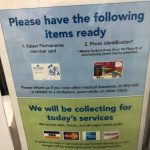 At each point of contact Pam’s details were verified with name, DOB, address, telephone number and MRN. Eligibility for member benefits was also checked at each point of contact, in this case ‘visiting member benefits.’ Pam was informed about financial costs for attending a ‘primary care’ appointment.
At each point of contact Pam’s details were verified with name, DOB, address, telephone number and MRN. Eligibility for member benefits was also checked at each point of contact, in this case ‘visiting member benefits.’ Pam was informed about financial costs for attending a ‘primary care’ appointment.
Cost & Insurance
When commencing employment Pam was offered a choice of insurers. Pam chose Kaiser Permanente insurance. If you are with Kaiser Permanente you need to attend a ‘Kaiser’ clinic or a hospital that accepts Kaiser insurance.
Insurance costs approximately $500 per month which employer deducts from wages. This covers spouse and any number of children up to age 26.
In addition there is a co-payment required for consultations:
$25 copay for a primary care (GP) visit.
$40 copay for a specialist consultation.
$50 copay for urgent care.
$200 copay for emergency.
Step One: Arrival
When we arrived we immediately saw two self check-in kiosks and a huge Pharmacy area which seemed to take the main focus of entry.
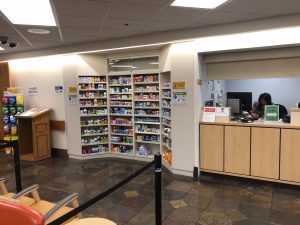
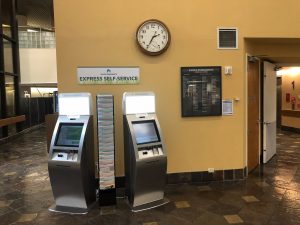
We looked for a person and saw a desk labelled ‘enquiries’ however this was unmanned. There was a sign on the desk saying ‘check in on level 1’. We went in search of level 1, found a lift but no button to level 1. We exited the lift and searched for a person to ask. A lovely lady at the Hearing Centre then told us we were on level 1, apparently entry was level 1. She kindly walked us all the way back to where we had entered the building and pointed us to a long queue and told us that is where you start. One of the reasons I wanted to do an independent study tour is to enable assessment through the eyes of a patient visiting for the first time. We all found this unnecessarily confusing.
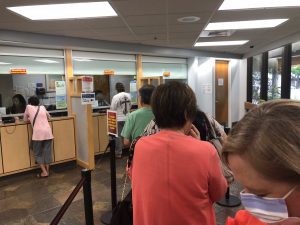
We then waited in the long queue for about 10 minutes. There was a strong security presence and while I was looking around the man behind me noticed my relative moving forward in response to her name being called. The man behind me in the queue was very upset on my behalf. He said “she just cut in on you, are you going to let her get away with that?” I said “Um, it’s ok, I am with her”.
Step Two: Consultations
Once we arrived Pam was directed to a small room where a nursing student came and introduced herself. She verified Pam’s details and took her blood pressure.
After she wrote Pam’s ‘vitals’ on a piece of paper we were asked to wait for a Licensed Practical Nurse (LPN). On questioning we learnt a LPN is a 2 year nursing degree (seems similar to our Endorsed Enrolled Nursing qualification). We waited 5 minutes.
The student nurse then did a verbal handover to the LPN who had arrived. The LPN entered details into the computer system (Epic). We were told the student nurses are not allowed access to the medical software at all.
We were then taken to a small consulting room and advised “a PA will see you soon”. A PA is a Physician’s Assistant. PAs are licensed to diagnose, treat and prescribe. My understanding is there should be a licensed doctor/physician on site also. (NB. There are discussions of a pilot program for PAs in Australia atm).
We waited approximately 10 minutes for the PA. She arrived and was very friendly. She said she had reviewed Pam’s previous notes (before entering consultation room) and asked if the infection had cleared and whether she had been checking her own blood pressure regularly.
In the visit she used the software to identify ‘care gaps’ and discussed screening and exercise recommendations.
The PA seemed to use software very efficiently. She had a lot of shortcuts programmed which she quickly edited to be relevant for the patient. She produced 1.5 pages of consultation notes in about 2 minutes (for a simple BP check) and printed the notes for Pam to use as a reference.
Patient Pam’s Comments
- “Paperwork was confusing – I just handed it back, don’t know whether it was right or not, just left most of it blank really.
- Facility was clean.
- Very professional and every staff member was very patient.
- I was surprised when the PA said she had read my notes.
- Very nice that they got chair for you and did not have a problem with observers being there.”
Clinician’s Perspective
- “Nurse should have been able to take the BP and assess. Did not also need to see a PA.
- The PA wearing a white coat and stethoscope would make people think she is a doctor, however she did clearly introduce herself.
- I’m very impressed the PA had taken the time to access and read previous visit notes. Knew there had been an infection 4 weeks prior and asked if it had cleared up. Asked if checking own blood pressure.
- Good continuity of care across states.
- Very impressed with how open they were with Katrina looking over their shoulder.
- I expect a doctor would have reviewed and signed off on the visit but would be good to clarify that.”
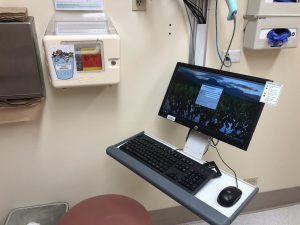
Practice Management & Health IT Assessment:
- Looked like a hospital
- Pharmacy check-in looked like a bank (privacy dividers).
- The two self check-in kiosks would be wonderful if you were a regular patient as you could avoid the long queues.
- Not a very pleasant or patient-centred
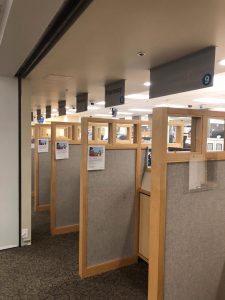
Pharmacy access scripts electronically through Epic environment.
- Strong security guard presence.
- All staff we came in contact with identified themselves very clearly and were extremely pleasant and helpful.
- There seemed very clear guidelines as to roles and
- Both LPN & PA
-
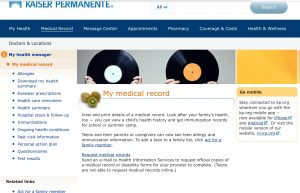
Patients portal allows access to entire record used the software well and reported they found the software “easy to use, no problems”. The PA said s
he had used Epic in other facilities and that it is customisable for each facility. She said the other facility’s version had “too much, too many screens and clicks” which made it harder to navigate.
Most impressive was the patient portal. Pam was able to access her entire medical record, all test results and showed me a graph tracking her health improvements.
Visit 2: Urgent Care Hawaii
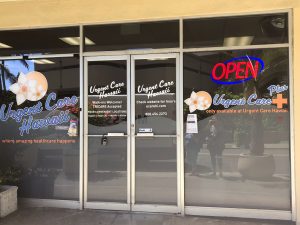 We walked into an urgent care facility and asked if we could see a clinician for a blood pressure check. Pam was asked about her insurance and when she said she has Kaiser insurance was advised they accept Tricare insurance and not Kaiser insurance. On questioning she was informed she could pay in full and not claim on her insurance and the cost to see a clinician would be $200.00.
We walked into an urgent care facility and asked if we could see a clinician for a blood pressure check. Pam was asked about her insurance and when she said she has Kaiser insurance was advised they accept Tricare insurance and not Kaiser insurance. On questioning she was informed she could pay in full and not claim on her insurance and the cost to see a clinician would be $200.00.
Next:
Now we head to Atlanta where we will be visiting various health facilities including:
- Orthopaedic Surgeon
- Cardiologist
- Regional Hospital
- Cancer Care Centre
- Allied Health facility with OT, Speech Pathologist, Physio (PT)
- Pharmacies (so far have seen these in every healthcare facility and in every supermarket).
Thanks for reading. If you have any questions or are interested in me looking at specific aspects of US healthcare please post a comment here or on my facebook page.
